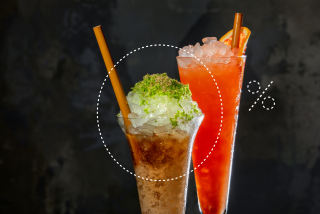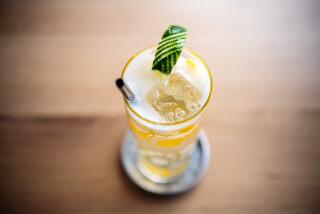The new Ice Age is elevating the craft cocktail

The Varnish’s cracked ice, made by Eric Alperin’s Penny Pound.
In 2015, maybe the one place on Earth where the ice isn’t melting faster than it should be is in your cocktail. At least if the ice in that highball glass has been made by one of the ice specialists helping to redefine the cocktail scene.
We’ve come a long way from using random bits of ice from industrial ice machines, haphazardly broken, composed of questionable water, quickly diluting the otherwise meticulously constructed contents of your craft cocktail.
Instead, the modern-day icemen use water that’s been double-filtered, often remineralized, frozen in Clinebell machines — the same machines that make the blocks of ice used for ice sculptures — that cool the ice from the bottom up into 300-pound blocks. Then that ice is painstakingly hand-cut into shapes sized specifically for your drink, chiseled into perfect monoliths, sometimes purposely formed without corners, then aged to create even greater density. It’s a meticulous process for that 2-by-2-by-2-inch rock that’s chilling your old-fashioned.
The Cocktail Issue: Jonathan Gold’s L.A. cocktail guide | Bartenders pour out their stories | Food and spirit pairings | Bar gear | Mocktails | The renaissance barman
“Ice is a bartender’s heat,” says Michel Dozois, whose company Neve (the word means a kind of compacted glacial ice) has been on the forefront of the specialty ice movement since Dozois started it way back in 2007 — a whole Ice Age ago in the world of craft cocktails. Dozois, a former bartender with an engineering background, worked at Comme Ça, Seven Grand and Church and State before his quest for ice led him to found his own ice company.
The ice as heat metaphor is one you hear often from this new generation of icemen, who often came up in restaurants and spent time working with chefs to pair drinks with food. But it’s also about controlling the elements — being able to manipulate not just how water is frozen but how it stays that way.
Dozois makes five kinds of ice at his factory in downtown Los Angeles. Last year it produced 100 tons, or 200,000 pounds, of perfect ice for your cocktails — all from L.A. tap water. Dozois’ machines, most of which he and his small crew invented, work to harness and control not only the temperature of the ice, but also its durability, density and clarity — all of which determines how the ice tastes and melts in your drink.
A few miles away, Eric Alperin is another accomplished bartender whose quest for ice has led him to start a specialty ice company. Alperin, who co-owns the Varnish, one of downtown’s best cocktail bars, founded the Penny Pound ice company two years ago. Based in downtown L.A., the ice shop is expanding its new digs in Little Tokyo.
“When I was working in New York,” says Alperin, who worked at Milk & Honey with barman Sasha Petraske, “we were freezing ice in pans, then sitting there with hammers and chisels.” Now the Tom Collins spears, old-fashioned rocks, rocks specifically designed for cocktail shaking and others made for hand-cracking and for punch — all these are cut by hand from the blocks of solid ice that come from Penny Pound’s four Clinebell machines. (The crushed ice comes from a Scotsman Ice machine.) Alperin estimates that the small bar, a speak-easy at the back of Cole’s, goes through 200 blocks on a busy night.
On a recent afternoon at the Varnish, Alperin arranged columns of ice on the bar like a sudden Stonehenge, watching as the pieces of perfectly clear ice clouded up at room temperature. Square cubes, called old-fashioned rocks, formed a makeshift pile like masonry at a construction site.
As Alperin made drinks, the ice fit neatly into the cocktail glasses like the system of geometry that it was. And later, the drinks made and consumed, the ice remained — barely eroded, our new Ice Age in a Collins glass.
More to Read
Eat your way across L.A.
Get our weekly Tasting Notes newsletter for reviews, news and more.
You may occasionally receive promotional content from the Los Angeles Times.











